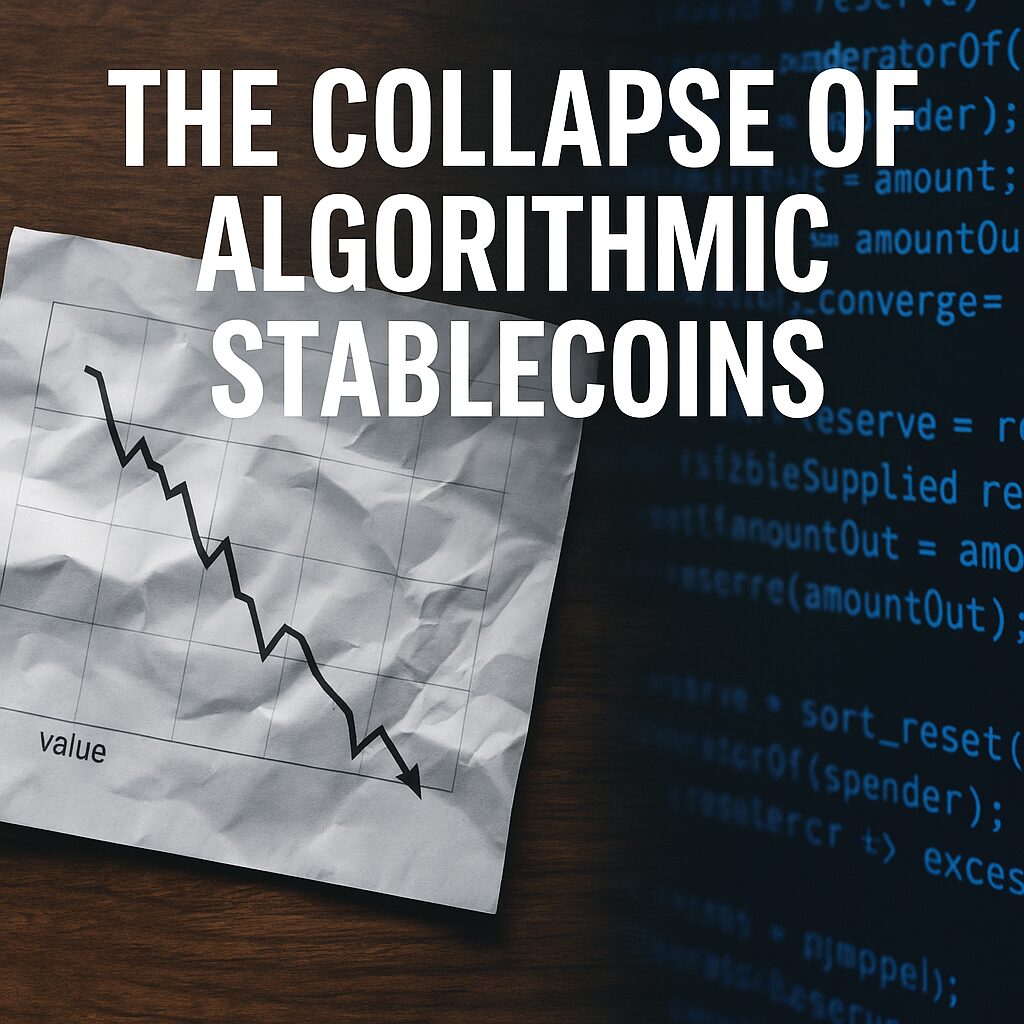The Mirage of Algorithmic Stability
In the age of decentralized finance (DeFi), algorithmic stablecoins once captured the imagination of crypto idealists.
They were presented as the perfect marriage between code and currency—fully decentralized, automated, and free from the whims of governments or central banks.
Prominent DeFi advocates hailed them as the next evolution in monetary systems, a digital currency that could maintain a stable value without any collateral backing.
The logic was compelling: eliminate the reliance on banks, ditch fiat reserves, and let smart contracts maintain stability through coded monetary policy.
At a time when distrust of traditional financial institutions was peaking, this vision was revolutionary.
But as markets matured and real capital began to flow in, the cracks in this utopian model began to show.
Unlike fiat-backed stablecoins like USDC or BUSD, which could point to real-world reserves, algorithmic stablecoins rested on a delicate balance of user trust, liquidity incentives, and speculative mechanisms.
As we would soon learn, this balance was not just delicate—it was dangerously fragile.
2. How Algorithmic Stablecoins Work – The Theory vs. Reality
At their core, algorithmic stablecoins aim to keep their price—usually pegged to the U.S. dollar—stable through supply-and-demand incentives.
The most common model involves a dual-token system:
- Stablecoin token (e.g., UST): meant to remain at $1
- Volatility token (e.g., LUNA): absorbs price shocks by expanding or contracting the supply
The process looks like this:
If demand for the stablecoin rises and its price goes above $1, the protocol mints more stablecoins by burning the volatility token, increasing supply and bringing the price down.
If demand falls and the price drops below $1, the system incentivizes users to burn stablecoins in exchange for volatility tokens, reducing supply and pushing the price up.
On paper, it’s a self-correcting loop.
However, in practice, the system is only as strong as the market’s belief in the value of the volatility token.
And this is where the system begins to unravel.
Once a peg is broken—especially during a market-wide panic—confidence in the volatility token collapses.
With no tangible reserves to back it, the system spirals into what’s called a death loop: more tokens are minted to restore the peg, but this only devalues the volatility token further, fueling the panic.
Numerous experiments like Basis, Empty Set Dollar, and IRON Finance attempted different variations of this algorithmic idea.
All promised innovation; most ended in disaster.
3. The Terra/LUNA Collapse: From $18B to Zero
No discussion of algorithmic stablecoins is complete without examining the catastrophic collapse of TerraUSD (UST) and its sister token, LUNA.
In early 2022, Terra was one of the most ambitious blockchain ecosystems in the world.
UST was used across DeFi apps, and LUNA was a top-10 cryptocurrency by market cap. The ecosystem boasted over $18 billion in value locked.
The crown jewel of Terra was Anchor Protocol, which promised nearly 20% APY for staking UST—far above typical DeFi yields.
But the system was built on fragile foundations.
When large withdrawals from Anchor began, the peg broke.
Investors rushed to exit UST, triggering a mass minting of LUNA to restore the peg.
Instead of calming the market, this hyperinflated the supply of LUNA, driving its price toward zero.
The so-called “algorithmic stabilization” failed in real-time.
Within days, UST dropped to under $0.10, and LUNA’s price collapsed by 99.99%.
Billions in investor capital vanished, and faith in algorithmic systems was shattered.
The collapse caused ripple effects far beyond Terra:
- Dozens of retail investors lost life savings
- Major hedge funds and exchanges suffered losses
- Trust in decentralized finance took a major hit
More importantly, the collapse caught the attention of regulators worldwide, who now had a concrete reason to scrutinize the industry.
4. The Domino Effect: Why Other Projects Also Died
Terra’s downfall wasn’t an isolated event. It was the match that lit a pile of dry tinder across the entire DeFi ecosystem.
As Terra/LUNA collapsed, liquidity dried up everywhere. Many other algorithmic stablecoin projects—some of which had already been showing signs of stress—also crumbled under market pressure.
Iron Finance
Backed by billionaire Mark Cuban, Iron Finance’s TITAN token collapsed in mid-2021 in a similar death spiral. The token lost virtually all its value within 48 hours, erasing over $2 billion in market cap. The project was abandoned, and investors were left holding worthless tokens.
Empty Set Dollar (ESD)
One of the earliest experiments in decentralized algorithmic currency, ESD relied heavily on user participation in “bonding” and “rebasing” mechanics. But as market conditions changed, user confidence faded, and the system never recovered. Its market cap dwindled from hundreds of millions to near-zero.
Basis Cash
Ironically, one of the architects of Basis Cash turned out to be Do Kwon, the same founder behind Terra. Basis Cash failed to maintain its peg, and developers quietly abandoned the project. Investors were again burned.
These collapses revealed a deeper systemic issue:
most algorithmic stablecoins depended more on game theory and speculative participation than on solid economics or collateral.
Once the momentum and hype wore off—or worse, reversed—these ecosystems had no foundation to stand on.
5. Structural Weaknesses Hidden in Code
Algorithmic stablecoins rely on smart contracts and coded incentives to manage supply and demand.
In theory, this eliminates human error. In practice, it simply hides structural fragility in layers of complexity.
Most algorithmic systems assume:
- Rational participants
- Adequate market liquidity
- Continuous arbitrage opportunities
- No coordinated attacks
- Infinite confidence in future redemption
But real markets are messy.
Rational actors become panicked actors
In a sudden downturn, investors act on fear—not logic.
Smart contracts can’t account for mass hysteria or coordinated exits.
Liquidity disappears when needed most
Many protocols depend on deep liquidity pools for arbitrage mechanisms to work.
During high volatility, liquidity providers pull out to avoid impermanent loss, rendering the peg-restoration mechanisms useless.
Game theory fails when confidence breaks
Stablecoins are only “stable” if people believe they are. Once trust evaporates, no code can rebuild it quickly enough.
Flash loan attacks and smart contract bugs
Algorithmic systems are vulnerable to manipulation via flash loans or code exploits.
Even minor flaws can be amplified to catastrophic levels in volatile markets.
Ultimately, these systems collapse not because of just one thing, but because of a cascade of failures—all embedded in the original design.
6. The Incentive Death Spiral
Perhaps the most dangerous flaw in algorithmic stablecoins is the incentive death spiral—a feedback loop where every corrective measure makes the problem worse.
Here’s how it works:
- Stablecoin loses peg (e.g., UST drops to $0.97)
- Protocol issues more volatility tokens (e.g., LUNA) to incentivize users to burn UST and restore the peg
- But investors lose confidence in LUNA’s value
- More LUNA is minted, flooding the market and crashing its price
- Lower LUNA value means it takes more LUNA to buy back 1 UST
- UST peg drops further
- Repeat, repeat, repeat…
This is exactly what happened to Terra. Within days, billions of LUNA were minted, diluting existing holders and destroying any hope of recovery.
The spiral accelerated because of:
- No redemption floor: Without a hard asset or collateral to back the stablecoin, there was no safety net.
- Speculative holders: Most participants weren’t long-term users, but short-term yield chasers.
- Platform liquidity drying up: As Anchor Protocol deposits evaporated, exit doors became crowded.
Algorithmic stablecoins are praised for not needing collateral. But in crisis, this becomes their fatal flaw.
No amount of clever coding can replace the market’s need for trust and tangible value.
7. Global Regulatory Backlash
The collapse of Terra and other algorithmic stablecoins didn’t just shake the crypto world—it caught the attention of global regulators.
🇺🇸 United States
U.S. Treasury Secretary Janet Yellen cited the Terra collapse in congressional testimony to argue for urgent regulation of stablecoins.
The Biden administration and SEC began treating algorithmic stablecoins as unregistered securities, subject to enforcement actions.
The 2022 Stablecoin TRUST Act proposed that all stablecoins be backed 1:1 by cash or highly liquid assets—effectively banning algorithmic models in the U.S.
🇪🇺 European Union
The EU’s MiCA (Markets in Crypto-Assets) framework also targets algorithmic coins.
MiCA requires transparency in operations, clarity in reserve structures, and licensing to operate across Europe—standards no major algorithmic coin has met.
🇸🇬 Singapore / 🇰🇷 South Korea / 🇯🇵 Japan
Following Terra’s collapse (notably with Korean founder Do Kwon), multiple Asian regulators began cracking down on unregistered crypto projects.
Extradition requests, police investigations, and financial fraud cases followed.
Global Impact
The G20 and IMF have both published papers warning about the systemic risks of algorithmic stablecoins, especially when adopted at scale.
Some have suggested they could become “shadow banks” that trigger wider financial instability.
Regulators now see algorithmic models not as innovation—but as unregulated systemic threats.
8. Surviving Algorithmic Experiments
Despite widespread failures, a few algorithmic stablecoin projects have survived, albeit with caveats.
FRAX
FRAX uses a hybrid model: it’s partially collateralized and partially algorithmic.
This allows it to maintain some market confidence during volatility, though it still depends on market dynamics and protocol incentives.
The project is actively adjusting its collateral ratio based on market demand, providing more flexibility.
DAI (by MakerDAO)
While technically not “algorithmic” in the classic sense, DAI relies on smart contracts and crypto-collateral to maintain its peg.
It has proven more resilient due to its overcollateralization model (e.g., $1.50 of ETH locked for every $1 DAI minted) and community governance.
Neutrino USD (USDN)
Once touted as a reliable algorithmic stablecoin on the Waves blockchain, USDN has also depegged multiple times.
It is currently under restructuring and scrutiny after losses and criticism around transparency.
The takeaway?
Fully algorithmic models with no collateral and no governance fail-safes are highly vulnerable.
The few survivors tend to hybridize or incorporate collateral to maintain legitimacy.
9. The Future of Algorithmic Designs
Even after multiple collapses, some developers remain committed to the dream of a purely decentralized, collateral-free currency.
The vision hasn’t died—but the methods are evolving.
Emerging designs now include:
- Multi-token architectures that include insurance or risk-absorbing tokens
- Dynamic supply algorithms based on market volatility instead of fixed logic
- Real-world asset anchors, like commodity-backed synthetic pairs
- Governance-based overrides to stop death spirals before they start
Academic institutions and blockchain think tanks are testing sandboxed models with circuit breakers, predictive pricing oracles, and adaptive incentives.
The hope is to retain decentralization without sacrificing stability.
However, the bar has been raised.
Future designs must prove they can:
- Survive black swan events
- Resist manipulation
- Maintain price stability in real-world use cases
- Meet regulatory compliance (or avoid triggering it)
In short, algorithmic stablecoins must mature beyond theory.
10. Final Verdict: The End or Just the Beginning?
Algorithmic stablecoins promised the moon—but most crashed back to earth.
They were elegant in whitepapers, mesmerizing in simulations, and catastrophic in reality.
Their fall shook investor confidence, wiped billions in wealth, and triggered a global regulatory response.
But innovation never truly stops.
While most early projects failed due to flawed assumptions and brittle incentives, the foundational idea—a decentralized, self-regulating currency—remains seductively powerful.
The next wave of designs will require more than code.
They’ll require governance, accountability, resilience, and perhaps… a healthy dose of humility.
📌 Coming Up Next:
“How to Use Stablecoins Without Falling Into Legal Trouble”
→ In our next post, we’ll reveal how to safely use stablecoins across borders without violating tax laws or compliance regulations. From transaction tracking tools to best practices for documentation, we’ll guide you through everything needed to stay safe, legal, and profitable.



